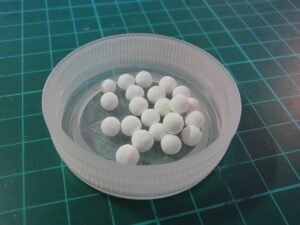Table of Contents
Alumina, as well known as aluminium oxide, is indeed a chemical compound composed primarily of oxygen and aluminium molecules. It really is a colourless crystalline substance found in nature in a variety of forms, the most common of which is sapphire and ruby, both of which are formed from corundum. Corundum is by far the most common naturally occurring crystalline form of alumina or aluminium oxide. Surprisingly, under certain conditions, corundum transforms into sapphire and ruby gemstones.

Alumina is often extracted from ores like bauxite, which is found in topsoil in tropical and subtropical regions. The Bayer process is being used to extract and refine alumina. The bauxite ground and dissolved in a sodium hydroxide solution in this step. The bauxite would then be converted into sodium aluminate at high temperatures, and impurities such as slag, also known as red mud or Fe2O3, are filtered out. Al(OH)3 precipitates as the Bayer liquor cools, leaving the silicates in solution.
Heating, as well as calcination of Al(OH)3 at around 1100°C, separates aluminium oxide particles. Alumina, once refined from bauxite, has the appearance of a white powder, similar to table salt or granular sugar.
Structure of Alumina
As explained previously, corundum is by far the most common crystalline form of alumina or aluminium oxide. The oxygen ions start to form a hexagonal close-packed structure in this case. In the meantime, two-thirds of the octahedral interstices are filled with aluminium ions. Every Al3+ centre has an octahedral shape.
Properties of Alumina
- The thermal conductivity of alumina seems to be good to excellent. It can withstand alkali and strong acid attacks at high temperatures.
- This has excellent dielectric properties.
- Metallic aluminium chemically reacts with atmospheric oxygen.
- This has a high degree of stiffness and strength.
- It’s indeed available in purity levels ranging from 94 per cent to 100 per cent.
- It isn’t soluble in water.
- Because alumina is an amphoteric substance, it can react with both acids and bases.
Reactions of Alumina
(1) Reaction with Sodium Hydroxide: The interaction of alumina with sodium hydroxide produces sodium aluminate (salt) and water. One such reaction takes place at temperatures ranging from 900 to 1100°C. Aluminium oxide exists to serve as an acid in this case.
Al2O3 + 2NaOH → 2NaAlO2 + H2O
(2) Reaction with Hydrochloric Acid: Aluminium chloride solution is created when alumina reacts with heated dilute hydrochloric acid. Because alumina contains oxide ions, it reacts with acids in the same way that magnesium or sodium oxides do.
Al2O3 + 6HCl → 2AlCl3+ 3H2O
Applications of Aluminium Oxides
- Alumina seems to be the primary raw material used in the manufacture of aluminium. 90% aluminium oxide is used in the production of aluminium metal, primarily through the electrolysis process.
- Electronic Substrates, Thread and Wire Guides, Seal Rings, Ballistic Armour, Thermometry Sensors, Grinding Media, Furnace Liner Tubes, High Voltage Insulators, and Laboratory Instrumentary Tubes are all common applications.
- Aluminium oxide is indeed an ingredient in a variety of glass formulations.
- It is used in purification, which is the process of removing water from gas streams. They find use in high-performance applications.
FAQs
What are the uses of alumina?
The most common oxide ceramic material is alumina. This has a wide range of applications, including spark plugs, tap washers, abrasion-resistant tiles, and cutting tools.
What type of material is alumina?
For chemical and physical stability, alumina is a very well fine ceramic material.






